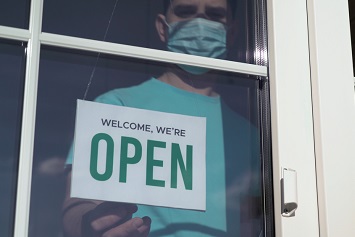For many years, the role of environment, health, and safety (EHS) managers was mainly behind the scenes. For EHS managers, simply developing and overseeing their organization’s safety programs reduced risk, but COVID-19 has changed the stakes, with risks played out center stage. Eric Glass, senior risk and safety advisor at UL, a leading global safety science company, recently sat down with EHS Daily Advisor to discuss this heightened emphasis and offer guidance on how EHS managers can keep not only their employees but also the public safe.
Our economy is opening back up. Will it ever get back to the way it was?
As work operations resume, one thing is clear: The world is not going to operate in the same manner as it did before COVID-19.
Looking back, what did you learn from this pandemic?
I think we learned a lot about ourselves and our organizations. At the onset of COVID-19, essential industries were quickly thrown into the “new normal” and were required to protect their employees and the public. It also confirmed that, with good leadership and effective, safety-minded personnel, it was easier to improvise, overcome, and adapt. Now, we wait for regulations to catch up. It will be interesting to see what new regulations are borne of this.
How valuable is the EHS professional during this pandemic and response?
When others in the organization looked for answers and direction for employee safety in light of COVID-19, it was EHS professionals who provided them. They harnessed their expertise and activated a hierarchy of controls—specifically, isolation, engineering, and administrative controls and transmission mitigation equipment (TME) use. Isolation was practiced by social distancing and shutting our doors. In the reopening and planning phase, administrative and engineering controls happened simultaneously. An example of this is a major home improvement retail organization utilizing two forms of TME by installing plexiglass at customer interaction points and requiring the use of face coverings for employees. Policies and employee training were quickly deployed to help ensure proper TME use and help mitigate virus spread. By drawing upon established protocols, EHS professionals were well prepared for this; it’s their day-to-day reality.
What should organizations be concerned with as they begin to reopen and resume “normal” operations?
Employees are the first line of defense for keeping the work environment safe. Organizations are taking a hard look at past, present, and future employee health and safety efforts. Compliance-based organizations, or those that only do what is required and nothing more, have found and will find this transition difficult. Those that drove safety in every element of their prepandemic operations and culture will find this to be an easy challenge to overcome. Leadership now has a newly found appreciation for well-informed, well-trained employees. Organizations are more open to soliciting the help from other third-party organizations to address specific issues that might be of concern.
UL works with many organizations globally. Are there any common issues that have been raised during the pandemic?
While situations vary among businesses and sectors, there are some consistent themes we are hearing from our customers:
- Employee education and training: Much emphasis is being placed on employee education and training efforts. In essence, employers are retraining employees to prevent confusion and potential mishaps. Organizations are reevaluating and reeducating employees on proper processes, procedures, and protocols. Leadership personnel understand that if their organization and their employees are not doing the right things, it can have a major negative impact on their brand and their bottom line.
- Improving contractor and vendor management programs: Contractor and vendor management is now being reevaluated and improved, as these interactions could be potential hazards to employees. They are evaluating written safety programs, safety management systems, training efforts, and overall safety performance, including injury logs, insurance loss runs, and internal metrics.
- Reexamining and modifying current processes and procedures: This pandemic has exposed poor processes and procedures, especially how incidents are reported. Organizations are very aware that any breakdown of reporting an incident, such as a COVID-19 exposure, could have catastrophic consequences. Job hazard analyses (JHAs) are now being reviewed or redone to identify potential hazards that could present themselves and to make sure employees are well aware of these changes.
In addition to the “new normal,” what else should businesses be concerned with?
There is also the “new expectation.” How an organization handled its COVID-19 response will have a tremendous impact on how it’s perceived by customers, employees, and potential hires. It also will impact how organizational leadership envisions the EHS role and responsibilities. All organizations are going through the “new expectation” thought process. Customers, clients, and consumers are, as well. It is likely that those reading this article closely watched the businesses they visited and paid close attention to how their favorite brand has been addressing this pandemic.
In addition to public health guidelines, what can businesses do to better protect the general public?
The expectation is that a business will go out of its way to make everyone safer. Organizations are now communicating messages in the media about the steps and precautions they are taking to better ensure the safety and well-being of everyone. As customers return, employees are being closely evaluated by the public, with the expectation that they are fulfilling what the organization has communicated. If employees are not properly prepared, the public will quickly take notice. This can have a negative impact on revenue and brand reputation. Compliance has always been a bare minimum that, when met, usually meant no real change in profitability. But will rudimentary compliance be enough going forward?
How will EHS help companies win in the marketplace?
COVID-19 has reset market share. In the very near future, we will see businesses be more aggressive in their efforts to retain their existing customers and expand market share by taking advantage of their competitors’ health and safety shortfalls. EHS can play a major role in helping organizations prepare for the “new expectation.”
What about the long-term ongoing safety protocols?
Public safety and employee safety are more aligned now than ever. The “new expectation” will create a “new, new normal.” Things that may seem temporary or overkill will take root. Things we are doing now may disappear or be replaced with a better process or a superior product. An organization’s leadership personnel should be asking themselves and others, “Will our organization be the industry benchmark, or will it simply be the one that is measured against another benchmark?” The former will be in the better position to protect the well-being of workers and the public; ensure organizational compliance; drive measurable business improvement; and, ultimately, be the inevitable marketplace leader.
 Eric Glass, a Senior EHS Advisor with UL, has 18 years of risk management, loss control, and safety experience. He is an Occupational Safety and Health Administration (OSHA) Outreach Trainer and advises companies on the design of advanced risk management and safety programs. In addition, Glass provides insight for workplace safety training and software development and contributes to UL’s Fire and Electrical Safety Audits offering for international ready-made garment factories. He also assisted with the development of Florida’s first continuing education safety curriculum for service contractors in the heating, ventilation, and air conditioning (HVAC); electrical; and plumbing industries. Eric Glass, a Senior EHS Advisor with UL, has 18 years of risk management, loss control, and safety experience. He is an Occupational Safety and Health Administration (OSHA) Outreach Trainer and advises companies on the design of advanced risk management and safety programs. In addition, Glass provides insight for workplace safety training and software development and contributes to UL’s Fire and Electrical Safety Audits offering for international ready-made garment factories. He also assisted with the development of Florida’s first continuing education safety curriculum for service contractors in the heating, ventilation, and air conditioning (HVAC); electrical; and plumbing industries. |


